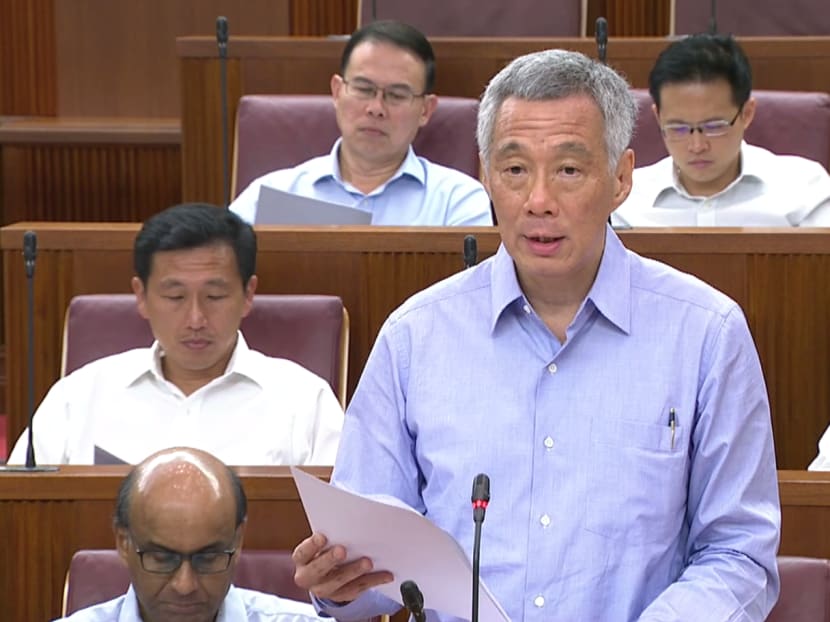Hsien Yang’s objection to Oxley house plan a ‘complete surprise’
SINGAPORE — No one in the family had raised objections to the plan approved by Mr Lee Kuan Yew before his death, which involved removing the private spaces and renovating the house without tearing it down.
SINGAPORE — No one in the family had raised objections to the plan approved by Mr Lee Kuan Yew before his death, which involved removing the private spaces and renovating the house without tearing it down.
It was only after their father died in March 2015 that Mr Lee Hsien Yang had, for the first time, voiced his disagreement with the proposal — and it came as a “complete surprise” to him, PM Lee said.
Delivering his Ministerial Statement in Parliament, PM Lee recalled how he and his wife, Ms Ho Ching, started discussing alternatives with Mr Lee Kuan Yew on what to do with the house, following the founding Prime Minister’s decision to bequeath 38 Oxley Road to PM Lee as part of his share of his father’s estate.
Given that they were aware of the way his parents felt about the house, and how the Cabinet and the public viewed the matter, PM Lee said the discussions were aimed at seeing “how best we could fulfil his wishes, in the event that the house could not be demolished”.
Mr Lee Kuan Yew was concerned that the house “should not become rundown and dilapidated, and that it should not be an expensive burden to maintain”, while Mrs Lee “felt strongly that her private living spaces should always remain private”, PM Lee recalled.
PM Lee and his wife came up with a proposal: Demolish the private living spaces to preserve the privacy of the family, but retain the basement dining room, “which was of historical significance”.
The decaying structure should also be strengthened, and a “new and separate living area” should be created so that the house could be lived in.
Accepting the idea, Mr Lee Kuan Yew “met the architect, went through the proposal, and approved the scheme to reinforce the foundations and renovate the house”, PM Lee said.
He added: “We kept the family fully informed of our considerations and intentions. We emailed everyone, including my father, my sister, my brother and his wife. No one raised any objections to the plan.”
Mr Lee Kuan Yew signed the authorisation to submit the development application to the Urban Redevelopment Authority (URA) on March 28, 2012. The authority approved the application about three weeks later.
“As far as I knew, that was how the family had settled the matter. Rationally, amicably while Mr Lee was still alive, which was what he had hoped to achieve, and strived very hard to achieve. I heard nothing to the contrary until after my father died,” PM Lee said.
It was at the reading of Mr Lee Kuan Yew’s will on April 12, 2015, that “a difference of views” emerged within the family, when he discussed with his siblings what he could say about the house in Parliament the following day.
“(Mr Lee Hsien Yang) for the first time objected to the renovation plans that my father had approved. He wanted the house to be knocked down immediately,” he said.
PM Lee said at that time, he pointed out that Mr Lee Hsien Yang’s position was different from what the family had discussed and agreed on, and it was not possible to knock the house down immediately, given that their sister, Dr Lee Wei Ling, had intended to continue to stay there.
PM Lee said he told his siblings that they should honour their father’s will to allow Dr Lee to stay in the house for as long as she wished, and he would say in Parliament that the Government would not make any decision until his sister is no longer staying there.
On their discussion on what PM Lee should say regarding their father’s wishes, Mr Lee Hsien Yang and his wife Mrs Lee Suet Fern had “objected strenuously” to PM Lee wanting to read in Parliament Mr Lee Kuan Yew’s 2011 letter to the Cabinet, stating his view on what to do with the house if it is to be preserved, as well as the full demolition clause in the will. But PM Lee said he decided he had to do so, such that his father’s views would be on record, and Singaporeans would know accurately what his thoughts were.
After the Parliament sitting, PM Lee said he took two “major steps”: Recusing himself from all Government decisions relating to the house, and placed Deputy Prime Minister Teo Chee Hean in charge. He also divested himself of the house.
“I was conflicted, being my father’s son, the inheritor of the house, and also the Head of the Government. It was not proper for me to take part in any decisions on 38 Oxley Road,” he said.
From that point on, he had been out of the loop whenever the Government handled matters concerning the house, PM Lee said.
Writing on Facebook after Monday's Parliament sitting, Dr Lee said her father “was never happy with Ho Ching’s so-called plans to renovate Oxley”.
He continued to ponder how he could have the house demolished, Dr Lee said.
In his statement, PM Lee noted that Mr Lee Kuan Yew had in March 2011 asked some newspaper editors for their views on the matter.
“All the editors replied that they would like it to be kept, given its historical importance and heritage value,” PM Lee said.
In response, Dr Lee said Mr Lee Kuan Yew was distressed when he saw the editors’ replies. “I scolded the SPH (Singapore Press Holdings) editors via email for distressing Pa & told them to leave Pa alone. If they wanted to see Oxley, I would show them around, but they were not to raise this issue (with) Pa again,” she said.







